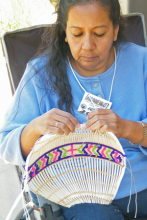Article
There are two groups of Paiute people, Northern and Southern, and although there are some similarities between them, the Northern and Souther Paiutes are each made up of a number of smaller, unique, nomadic bands with their own specific cultural traditions. The Paiute refer to themselves as "Nuwu," or "person," and have dwelt in the Great Basin region since about CE 1000-1200. Paiute may have meant "Water Ute" or "True Ute" and was used to refer only to the Southern Paiute until the 1850s.
Because the Southern Paiute continue to live in what is now southwest Utah, southern Nevada, and northwest Arizona, Tony Hillerman is most likely referring to them in his Navajo detective novel series, as most of the action for the series occurs in the Southwestern U.S..
"Kaibab Band of Paiutes Tribe member Angie Bulletts weaves a traditional Paiute cradleboard, June 3, 2011" by U.S. Forest Service, Southwestern Region, Kaibab National Forest is licensed under CC BY-SA.
Manuscripts
References
Hoxie, Frederick E., editor
1996 Encyclopedia of North American Indians. Boston: Houghton Mifflin Company.
Pritzker, Barry M.
2014 Northern Paiute. The American Mosaic. Http://americanindian2.abc-clio.com/Search/Display/1463272?terms=paiute, accessed June 17, 2014.
Pritzker, Barry M.
2014 Southern Paiute. The American Mosaic.http://americanindian2.abc-clio.com/Search/Display/1463274?terms=paiute, accessed June 17, 2014.

